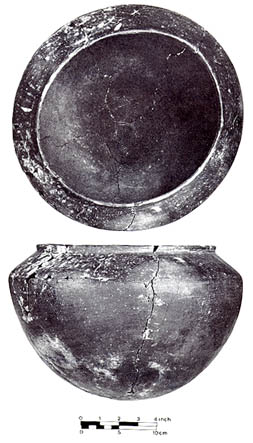 Powell Plain vessel, Julien site.
Powell Plain vessel, Julien site.
The ceramics of the Stirling phase are particularly well known. Although many of its attributes (size, shape, and thickness) are almost identical to Powell Plain vessels, it may be a mistake to conclude that Ramey-Incised vessels are simply decorated and burnished versions of Powell Plain ceramics. There are several reasons why Ramey-Incised pottery carries more meaning than just "decorated Powell Plain." First, the context in which some Ramey-Incised vessels are found strongly argues for their socio-religious importance. They have been found associated with specialized structures (e.g., non-residential structure at the BBB Motor site) and are often found with other elite goods fashioned from exotic materials. Second, the symbolism evident in Ramey-Incised designs is most often interpreted as having underworld or water connections. Accordingly, Ramey-Incised pottery apparently functioned as more than vessels for the elite, which they certainly were. It seems likely that they also played an important role in religious ritual. The same is likely true of effigy vessels as well.